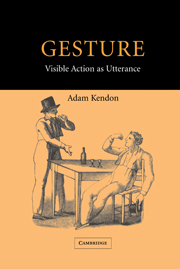Book contents
- Frontmatter
- Contents
- Acknowledgments
- 1 The domain of gesture
- 2 Visible action as gesture
- 3 Western interest in gesture from Classical Antiquity to the eighteenth century
- 4 Four contributions from the nineteenth century: Andrea de Jorio, Edward Tylor, Garrick Mallery and Wilhelm Wundt
- 5 Gesture studies in the twentieth century: recession and return
- 6 Classifying gestures
- 7 Gesture units, gesture phrases and speech
- 8 Deployments of gesture in the utterance
- 9 Gesture and speech in semantic interaction
- 10 Gesture and referential meaning
- 11 On pointing
- 12 Gestures of ‘precision grip’: topic, comment and question markers
- 13 Two gesture families of the open hand
- 14 Gesture without speech: the emergence of kinesic codes
- 15 ‘Gesture’ and ‘sign’ on common ground
- 16 Gesture, culture and the communication economy
- 17 The status of gesture
- Appendix I Transcription conventions
- Appendix II The recordings
- References
- Index
16 - Gesture, culture and the communication economy
Published online by Cambridge University Press: 05 February 2015
- Frontmatter
- Contents
- Acknowledgments
- 1 The domain of gesture
- 2 Visible action as gesture
- 3 Western interest in gesture from Classical Antiquity to the eighteenth century
- 4 Four contributions from the nineteenth century: Andrea de Jorio, Edward Tylor, Garrick Mallery and Wilhelm Wundt
- 5 Gesture studies in the twentieth century: recession and return
- 6 Classifying gestures
- 7 Gesture units, gesture phrases and speech
- 8 Deployments of gesture in the utterance
- 9 Gesture and speech in semantic interaction
- 10 Gesture and referential meaning
- 11 On pointing
- 12 Gestures of ‘precision grip’: topic, comment and question markers
- 13 Two gesture families of the open hand
- 14 Gesture without speech: the emergence of kinesic codes
- 15 ‘Gesture’ and ‘sign’ on common ground
- 16 Gesture, culture and the communication economy
- 17 The status of gesture
- Appendix I Transcription conventions
- Appendix II The recordings
- References
- Index
Summary
As we saw in Chapter 3, the idea that gesture could serve as a universal language was widely entertained in the seventeenth century. Both Bonifacio and Bulwer believed that it was a natural form of expression that could be understood universally and Bonifacio, explicitly, hoped that his book L'Arte dei Cenn might contribute to the re-establishment of gesture as a common mode of communication and thus return mankind to the state it was in before it strayed from its God-given existence, when communication was unimpeded by the difficulties created by different spoken languages. The idea that gesture could form the basis of a universal language continued during the eighteenth century. However, despite the efforts of Abbé de l'Epée, his pupil Sicard, and others, it was soon realized that a gesture language, like any other, would diversify with use and was not inherently superior as a basis for a universal language.
Nevertheless, the idea that gesture is a universal form of expression that does not need to be learned to be understood has remained a very persistent one. At the same time, it has also always been recognized that there are differences from one nation to the next, from one culture to the next or from one stratum of society to the next, in how gesture is used and differences in the specific gestures employed in different cultures has long been noted.
- Type
- Chapter
- Information
- GestureVisible Action as Utterance, pp. 326 - 354Publisher: Cambridge University PressPrint publication year: 2004
- 2
- Cited by

